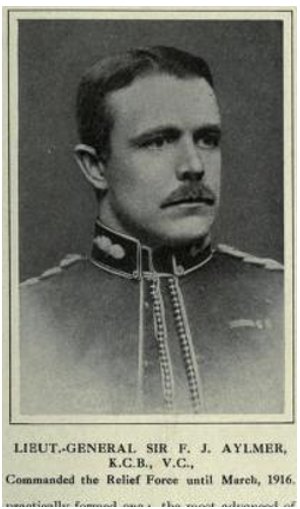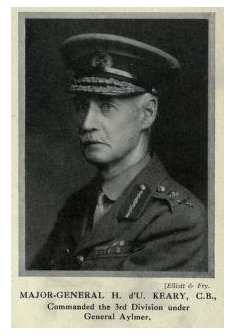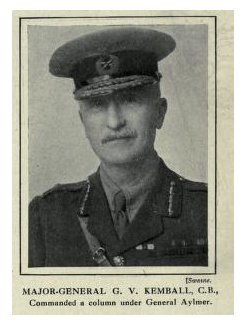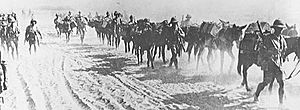Battle of Dujaila facts for kids
Quick facts for kids Battle of Dujaila |
|||||||
|---|---|---|---|---|---|---|---|
| Part of the Mesopotamian Campaign of World War I | |||||||
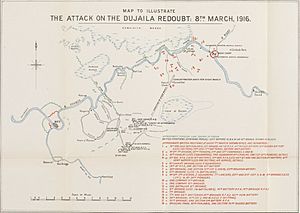 A detailed map showing the attack on the Dujaila Redoubt |
|||||||
|
|||||||
| Belligerents | |||||||
|
|||||||
| Commanders and leaders | |||||||
| Strength | |||||||
| 18,891 infantry 1,268 Cavalry 68 artillery pieces |
8,500 infantry 1,500 cavalry 32 artillery pieces |
||||||
| Casualties and losses | |||||||
| 3,500 casualties | 1,290 casualties | ||||||
The Battle of Dujaila was a fight between British and Ottoman forces during World War I. It happened on March 8, 1916. Ottoman troops, led by Colmar Freiherr von der Goltz, were surrounding the city of Kut. A British-Indian force, led by Lieutenant-General Fenton Aylmer, tried to rescue the city. But their attempt failed, and Aylmer's force lost 3,500 soldiers.
Contents
Why the Battle Happened
British Goals in Mesopotamia
For most of 1915, British and Indian forces, called the Indian Expeditionary Force D, moved up the Tigris and Euphrates rivers. Their first goal was to capture areas like Shatt al Arab and Basra. This was to protect British oil fields in Iran.
But their mission grew. Commanders saw chances to win battles and boost the British Empire's reputation. They defeated parts of the Ottoman Sixth Army in several battles. After these wins, the British-Indian force controlled much of the Tigris and Euphrates rivers in what is now southern Iraq.
Pushing Towards Baghdad
The British commanders felt they were close to capturing Baghdad. They asked for permission to attack it. British spies believed the nearest Ottoman backup troops were very far away. They thought only two weak Ottoman divisions stood in their way.
However, officials in London were against advancing further. They worried that even if Baghdad was captured, it would be lost again. There were no extra troops to help Force "D". Despite warnings from military leaders, the decision to advance was made.
In late 1915, Force "D" had only one division, the 6th (Poona) Division, ready for attack. This division fought in the Battle of Ctesiphon. They won the battle, but it was a very costly victory. So many soldiers were lost that the Poona Division had to retreat to Kut.
The Siege of Kut
The Ottoman Sixth Army, now stronger, chased the British and surrounded the town of Kut. They tried to storm the British-Indian positions but failed. Instead, they decided to wait, hoping to starve the Kut defenders into giving up.
The soldiers in Kut depended on their food supply. It was thought their food would run out by mid-February 1916. But then, more food was found in late January. This meant they could last until mid-April 1916.
With the Poona Division trapped, British leaders in London and India quickly put together a rescue force. Lieutenant-General Fenton Aylmer was chosen to lead this group, called the Tigris Corps. Their first attempt to rescue the Kut soldiers failed at the Battle of Hanna on January 21, 1916.
Getting Ready for Battle
After the defeat at Hanna in January 1916, Lieutenant-General Aylmer's Tigris Corps spent February getting ready again. They gathered more soldiers and supplies. But the Tigris Corps still wasn't at full strength.
The British situation in Kut was getting worse. Food was expected to last only until mid-April. Also, the weather was a concern. The good weather was expected to last only until mid-March. After that, the spring thaw and rainy season would turn the land into a muddy swamp.
Many of the Tigris Corps' groups of soldiers were still small. To fix this, soldiers from different units were combined to make stronger groups. Also, new soldiers meant for the trapped units in Kut formed temporary groups.
In 1916, there were almost no paved roads in Mesopotamia. There were no railroads either. Beyond the port of Basra, transport was difficult. Soldiers and supplies moved by animals on dirt paths or by boats on the river. Both needed enough water to work well. The Tigris River was wide but often too shallow for many ships. Areas away from the river often flooded. So, the river was the main way to transport things over long distances. But the British didn't have enough boats for the Tigris Corps.
Choosing the Attack Plan
The Ottoman defenses at Hanna were very strong. The British-Indian forces needed to find a way around them. One option was to march about 30 miles through the desert. This would let them get around the Ottoman defenses. Then, they would break through the Ottoman lines and meet the Kut soldiers.
The other option was to stay along the Tigris River but move to the right bank. This would mean breaking through Ottoman defenses at a place called Dujaila.
Lieutenant-General Aylmer didn't want to leave the Tigris River. It was an easy way to get supplies from Basra. So, he decided to attack along the right bank. This area was mostly flat and had little cover. The Ottoman soldiers, with German advisors, were good at hiding their positions. This made it hard for the British and Indian units to find them.
The British knew the Ottomans were building a strong fort, called a redoubt, at Dujaila. Aylmer and his staff planned a night attack. Most of his force would attack at night. A smaller group would stay on the left bank to distract the Ottomans.
Before starting the plan, Aylmer needed approval from the new commander of I.E.F. D, Lieutenant-General Sir Percy Lake. After the Hanna battle, General Lake had started to lose trust in Aylmer's leadership. To have more control, Lake replaced Aylmer's chief of staff with his own man, Major-General George Gorringe.
Aylmer also didn't trust his own commanders. He had two main division commanders. But he chose Major-General George Kemball, one of his brigade commanders, to lead two of the three attack groups. Aylmer said Kemball was more energetic. The other division commander was sent to lead the distraction force.
Ottoman Preparations
Like the British, the Ottoman Sixth Army also had trouble getting supplies. There were no good roads or railways. This made it very hard to get new soldiers and supplies quickly. But the Ottoman army had time on their side. They knew they were at the edge of their supply lines from Baghdad.
The Ottomans were very good at trench warfare. They had learned a lot from their victory at Gallipoli. The Ottoman Sixth Army had built a complex network of trenches around Kut since December 1915.
Further downriver, Field Marshal von der Goltz and his Ottoman commander, Khalil Pasha, built strong defensive positions. These were at Hanna and Sanniyat on the left bank of the river, and Dujaila on the right bank.
Because the British commander in Kut, Townshend, stayed on defense, the Ottoman army could move most of their troops south. In total, the Ottoman Sixth Army had about 25,000 men, 1,200 cavalry, and 80 artillery guns. Von Der Goltz moved most of his forces south, leaving only about 2,000 men to continue the siege of Kut.
On the left bank, Ottoman divisions still held the Hanna line. On the right bank of the Tigris, at Dujaila, 8,500 men, 1,500 cavalry, and 32 artillery guns defended the position.
The Ottoman commander knew the British might try to break the siege by attacking on the right bank. So, he ordered the Dujaila redoubt to be built. Aylmer later said he chose to attack on the right bank because the redoubt was new. But by the time of the attack, the Ottomans had greatly improved the position. It had a sloped bank, called a glacis, that was 25 feet high in some places.
The Battle Begins
Aylmer's plan divided his force into three groups (A, B, and C). Groups A and B were together under Major-General Kemball. Group C, led by Major-General Kearny, was the reserve. On the night of March 7, 1916, the entire force crossed the river. They prepared for a night march to the Dujaila redoubt. There were no clear landmarks in the dark. So, each group had to use a compass and count their steps to navigate.
In the darkness, things went wrong. Groups A and B got separated and lost contact. This slowed their advance as they tried to find each other. The artillery also got lost and arrived almost an hour and a half late.
Despite a two-hour delay, the main attack groups of A and B were in position just before dawn on March 8, 1916. The lead soldiers of the 26th Punjabis pushed forward. They entered the Dujaila position and found only a few surprised Ottoman soldiers. They reported back to Kemball that they had achieved surprise.
However, even though they had completely surprised the enemy, Kemball ordered his units to wait. He wanted them to wait until the planned attack time. He even told the Punjabis to pull back from the Ottoman positions. Three hours passed before Kemball allowed the 36th Brigade to attack the Dujaila redoubt.
By the time Kemball allowed the attack, all hope of surprise was gone. As the artillery started firing, Von Der Goltz began moving the 52nd Division from his reserve on the left bank. These soldiers reinforced the Ottoman divisions, who were now fully awake and ready in their trenches. By the end of the battle, nearly 8,000 men were moved across the river. This effectively doubled the strength of the Ottoman forces on the right bank.
Some of Aylmer's attack force was in position, but some were still trying to get organized from the night march. One unit, the 37th Indian Brigade, reached its starting point on time. It was with Kearny, Aylmer, and Gorringe. Even though they found a gap in the enemy lines, the commanders held the 37th Brigade back. They ordered it to wait and follow the plan's schedule. The infantry attack, planned for 7:15 a.m., did not start until later.
The artillery, which should have started firing earlier, didn't begin until almost 7 a.m. Once the firing started, all surprise was lost. Throughout the day, the British-Indian soldiers attacked the Ottoman positions. But they were stopped and pushed back by machine gun and artillery fire.
Despite the missed chances, the new Ottoman soldiers, and the strong defenses, the British were almost ready for a breakthrough by late afternoon. The 59th Scinde Rifles (Frontier Force) and 1st Manchester Regiment managed to capture the first two lines of trenches at the Dujaila Redoubt.
But they had no extra soldiers to use this success. The two battalions could only hold onto what they had gained. Slowly, the Ottoman battalions counter-attacked with bayonets and grenades. The British had very few grenades. This forced the Manchester's and Rifles to retreat in the early evening. Of the 2,301 men in the 8th Brigade, 1,174 were injured or killed by the end of the day.
In total, the Tigris Corps suffered almost 4,000 casualties. During the night, the British forces pulled back to a meeting point. When no Ottoman counter-attack happened, Aylmer ordered his troops back across the river. This ended the battle.
What Happened Next
The failure at Dujaila meant the end for Aylmer. On March 12, 1916, Lake removed him from command. This happened after the War Office received the report of the defeat. Gorringe was then put in charge of the Tigris Corps.
After the defeat, the yearly floods began. Melted snow from the Zagros Mountains caused the rivers to rise. The Mesopotamian plain turned into a sea of mud and flooded areas. The morale of the Tigris Corps began to drop. When news of the Dujaila defeat reached the 6th (Poona) Division, Indian Muslim soldiers started to leave. They were already unsure about fighting against other Muslims.
For the rest of March, the Tigris Corps waited for more soldiers. These included the all-British 13th (Western) Division. Once they were stronger, they would try one more time to break the siege before Townshend's soldiers ran out of food.
Images for kids


